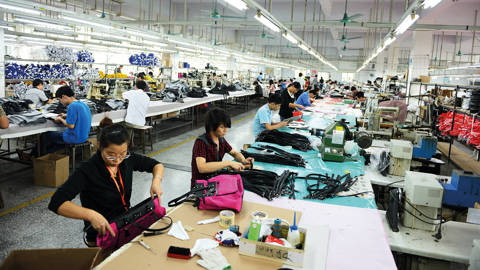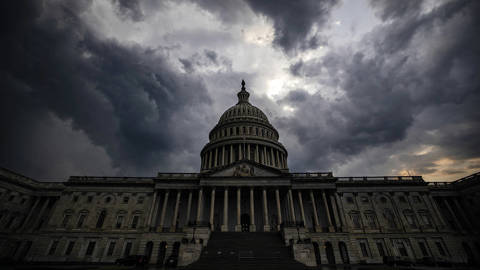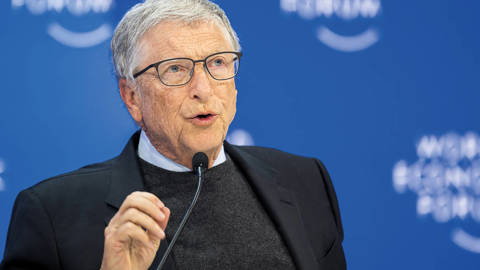The current AI boom looks a lot like the tech industry's rebound 30 years ago, when the commercialization of the internet ended an earlier period of malaise. But whereas the internet era fundamentally disrupted the technology industry, AI promises to make Big Tech stronger than ever.
SEATTLE – In November 1991, Time magazine released a special issue assessing the state of California, and the prognosis was grim. The cover featured a blood-red sunset sinking into a sea of rolling coastal fog, and one dispatch after another lamented the state’s faltering economy, political strife, fires and earthquakes, and the perennial rivalry between San Francisco and Los Angeles.
Gloomier still was Time’s dissection of Silicon Valley. After riding high on the personal-computer boom of the 1980s, the region was experiencing a “wrenching mid-life crisis” thanks to post-Cold War defense cuts, a plateauing PC market, and Japanese competition in chipmaking. The recession had swamped Boston and other high-tech regions, too, but the Valley’s decline seemed particularly painful. “The whole world would be wise to pay close attention to the drama of incipient decline and resistance now unfolding in California,” the editors warned. “For the future that begins there tends to spread across the world.”
At the start of 2023, Silicon Valley was in a similar funk. Tech companies were weathering sagging stock prices, mass layoffs, a burst crypto bubble, and a metaverse that had turned out to be rather “meh.” Antitrust suits were gaining momentum, and billionaire CEOs were being chastised for their excessive wealth and mocked for their extreme hobbies. The collapse of Silicon Valley Bank in March felt like a flashback to the early 1990s, when plummeting housing prices eviscerated SVB’s real-estate-heavy investment portfolio.
One year later, the layoffs have continued and the regulators still loom, but the artificial-intelligence boom has the Valley humming once again. Nearly $50 billion of venture capital flowed into generative AI and AI-related startups in 2023. San Francisco’s Victorian mansions are now incubators for elixir-drinking, rap-battling AI entrepreneurs. Nvidia, whose advanced chips power large language models like OpenAI’s ChatGPT, now has a market valuation above $1 trillion. The tech sector’s “Big Five” have expanded into the “Magnificent Seven”: Alphabet, Amazon, Apple, Meta, Microsoft, Nvidia, and Tesla. In January, these companies’ AI-buoyed stock prices helped push the S&P 500 to an all-time high.
A similar rebound happened 30 years ago, when the internet boom finally swept away the tech-sector malaise that Time had captured. After that, the industry grew richer and more consequential. Today’s tech titans have eagerly seized on this parallel, with many declaring AI to be an even bigger transformation than the internet.
There is an important difference, though. Whereas the internet era fundamentally disrupted the technology industry, the AI boom is making Big Tech stronger than ever.
Prior to the 1990s, the Valley was dominated by hardware manufacturers: computer makers, defense electronics firms, and the semiconductor companies that put the “silicon” in Silicon Valley. The industry’s biggest companies were mostly headquartered elsewhere. IBM was in New York, Digital Equipment Corporation and Data General were in Boston, and Texas Instruments was in Dallas.
The dot-com era changed all that. The tech world’s center of gravity shifted to Silicon Valley and Seattle. A new generation of firms rose up, specializing in very different things. Hardware and infrastructure still mattered, of course (Nvidia was established in 1993, just before the dot-com boom). But most of the attention, talent, and money from the mid-1990s onward flowed to software and internet companies, many of which were young startups with untested founders – including Amazon (founded in 1994), Google (1998), and Facebook (2004).
US technology policy encouraged this transition. Telecommunications reforms in the 1990s strengthened and subsidized the country’s information infrastructure. Policymakers stepped in to prevent large cable and telecom companies from restricting internet traffic, and to grant internet firms freedom from liability for most online content (a decision with fateful consequences in the social-media age).
The current AI boom is producing a new wave of startups, too. But most of these are building tools on the back of technologies that are financed or owned by large platform companies. Big Tech firms, after all, are practically the only entities with the superabundance of data, computing power, and cash required to make advanced AI possible. The leading generative AI models have come either from Big Tech-funded firms – such as OpenAI (which received a $10 billion investment from Microsoft) and Anthropic ($4 billion from Amazon) – or from the tech giants themselves.
This dominance stands in sharp contrast to the 1990s internet, which was federally created, subsidized, and regulated to keep market incumbents in check. Near-term AI regulation may not have the same structural effect. Most of the focus has rightly been on AI models’ potential societal harms. But the tech titans also are at the center of the regulatory conversation, briefing Congress, meeting heads of state, and explaining their bafflingly complex technology (in their own terms, of course) to the world.
While many tech leaders have paid lip service to the need for caution, the overall mood is bullish. At a closed-door briefing in Washington last summer, the technology ethicist Tristan Harris marveled at the power and wealth of those assembled around the table. “There’s more than $6 trillion worth of tech that is advocating for accelerating the deployment of AI,” he observed. “The stakes really feel very, very high.”
It is too early to tell where the current AI moment will take us. The November 1991 issue of Time attests to the futility of trying to make concrete predictions about technology and its broader effects on the economy. “With manufacturing moving out to cheaper areas, many locals fear that the Valley may simply end up as a research-and-development backwater,” Scott Brown reported. “Moreover, at a time when American investors remain wary of committing to new companies, more and more Japanese companies are funding startups, which prompts worries that foreign ownership may eventually characterize the region.”
Hardware manufacturing did indeed move away. But Silicon Valley firms like Intel and Apple ultimately profited richly from that outsourcing. Worries about foreign investment vaporized along with Japan’s asset-price bubble and subsequent economic stagnation. Far from becoming a backwater, the Valley was utterly transformed by the internet, a technology that seemed so irrelevant to the business of tech that Time’s coverage in 1991 never even mentioned it.
A mere three weeks after that gloomy cover story, US President George H.W. Bush signed a law to strengthen and expand America’s information infrastructure, and the government opened the network to commercial users soon thereafter. That set the stage for browsers, search engines, social networks, and smartphones, and then for companies with the wealth and resources to make advanced AI happen. The sun wasn’t setting; it was just beginning to rise.






SEATTLE – In November 1991, Time magazine released a special issue assessing the state of California, and the prognosis was grim. The cover featured a blood-red sunset sinking into a sea of rolling coastal fog, and one dispatch after another lamented the state’s faltering economy, political strife, fires and earthquakes, and the perennial rivalry between San Francisco and Los Angeles.
Gloomier still was Time’s dissection of Silicon Valley. After riding high on the personal-computer boom of the 1980s, the region was experiencing a “wrenching mid-life crisis” thanks to post-Cold War defense cuts, a plateauing PC market, and Japanese competition in chipmaking. The recession had swamped Boston and other high-tech regions, too, but the Valley’s decline seemed particularly painful. “The whole world would be wise to pay close attention to the drama of incipient decline and resistance now unfolding in California,” the editors warned. “For the future that begins there tends to spread across the world.”
At the start of 2023, Silicon Valley was in a similar funk. Tech companies were weathering sagging stock prices, mass layoffs, a burst crypto bubble, and a metaverse that had turned out to be rather “meh.” Antitrust suits were gaining momentum, and billionaire CEOs were being chastised for their excessive wealth and mocked for their extreme hobbies. The collapse of Silicon Valley Bank in March felt like a flashback to the early 1990s, when plummeting housing prices eviscerated SVB’s real-estate-heavy investment portfolio.
One year later, the layoffs have continued and the regulators still loom, but the artificial-intelligence boom has the Valley humming once again. Nearly $50 billion of venture capital flowed into generative AI and AI-related startups in 2023. San Francisco’s Victorian mansions are now incubators for elixir-drinking, rap-battling AI entrepreneurs. Nvidia, whose advanced chips power large language models like OpenAI’s ChatGPT, now has a market valuation above $1 trillion. The tech sector’s “Big Five” have expanded into the “Magnificent Seven”: Alphabet, Amazon, Apple, Meta, Microsoft, Nvidia, and Tesla. In January, these companies’ AI-buoyed stock prices helped push the S&P 500 to an all-time high.
A similar rebound happened 30 years ago, when the internet boom finally swept away the tech-sector malaise that Time had captured. After that, the industry grew richer and more consequential. Today’s tech titans have eagerly seized on this parallel, with many declaring AI to be an even bigger transformation than the internet.
There is an important difference, though. Whereas the internet era fundamentally disrupted the technology industry, the AI boom is making Big Tech stronger than ever.
SPRING SALE: Save 40% on all new Digital or Digital Plus subscriptions
Subscribe now to gain greater access to Project Syndicate – including every commentary and our entire On Point suite of subscriber-exclusive content – starting at just $49.99.
Subscribe Now
Prior to the 1990s, the Valley was dominated by hardware manufacturers: computer makers, defense electronics firms, and the semiconductor companies that put the “silicon” in Silicon Valley. The industry’s biggest companies were mostly headquartered elsewhere. IBM was in New York, Digital Equipment Corporation and Data General were in Boston, and Texas Instruments was in Dallas.
The dot-com era changed all that. The tech world’s center of gravity shifted to Silicon Valley and Seattle. A new generation of firms rose up, specializing in very different things. Hardware and infrastructure still mattered, of course (Nvidia was established in 1993, just before the dot-com boom). But most of the attention, talent, and money from the mid-1990s onward flowed to software and internet companies, many of which were young startups with untested founders – including Amazon (founded in 1994), Google (1998), and Facebook (2004).
US technology policy encouraged this transition. Telecommunications reforms in the 1990s strengthened and subsidized the country’s information infrastructure. Policymakers stepped in to prevent large cable and telecom companies from restricting internet traffic, and to grant internet firms freedom from liability for most online content (a decision with fateful consequences in the social-media age).
The current AI boom is producing a new wave of startups, too. But most of these are building tools on the back of technologies that are financed or owned by large platform companies. Big Tech firms, after all, are practically the only entities with the superabundance of data, computing power, and cash required to make advanced AI possible. The leading generative AI models have come either from Big Tech-funded firms – such as OpenAI (which received a $10 billion investment from Microsoft) and Anthropic ($4 billion from Amazon) – or from the tech giants themselves.
This dominance stands in sharp contrast to the 1990s internet, which was federally created, subsidized, and regulated to keep market incumbents in check. Near-term AI regulation may not have the same structural effect. Most of the focus has rightly been on AI models’ potential societal harms. But the tech titans also are at the center of the regulatory conversation, briefing Congress, meeting heads of state, and explaining their bafflingly complex technology (in their own terms, of course) to the world.
While many tech leaders have paid lip service to the need for caution, the overall mood is bullish. At a closed-door briefing in Washington last summer, the technology ethicist Tristan Harris marveled at the power and wealth of those assembled around the table. “There’s more than $6 trillion worth of tech that is advocating for accelerating the deployment of AI,” he observed. “The stakes really feel very, very high.”
It is too early to tell where the current AI moment will take us. The November 1991 issue of Time attests to the futility of trying to make concrete predictions about technology and its broader effects on the economy. “With manufacturing moving out to cheaper areas, many locals fear that the Valley may simply end up as a research-and-development backwater,” Scott Brown reported. “Moreover, at a time when American investors remain wary of committing to new companies, more and more Japanese companies are funding startups, which prompts worries that foreign ownership may eventually characterize the region.”
Hardware manufacturing did indeed move away. But Silicon Valley firms like Intel and Apple ultimately profited richly from that outsourcing. Worries about foreign investment vaporized along with Japan’s asset-price bubble and subsequent economic stagnation. Far from becoming a backwater, the Valley was utterly transformed by the internet, a technology that seemed so irrelevant to the business of tech that Time’s coverage in 1991 never even mentioned it.
A mere three weeks after that gloomy cover story, US President George H.W. Bush signed a law to strengthen and expand America’s information infrastructure, and the government opened the network to commercial users soon thereafter. That set the stage for browsers, search engines, social networks, and smartphones, and then for companies with the wealth and resources to make advanced AI happen. The sun wasn’t setting; it was just beginning to rise.